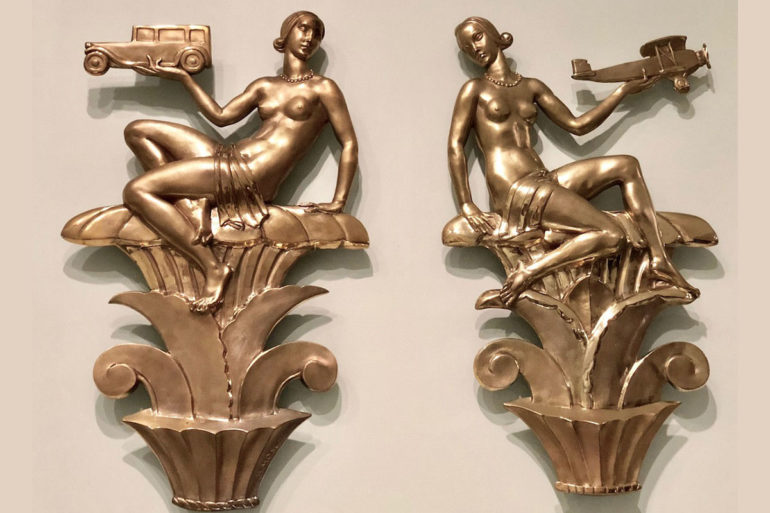
This post is also available in:

It was inaugurated on October 18 in VIP preview at the Wolfsonian Museum-FIU based in the Art Deco district of Miami Beach, DECO: Luxury to Mass Market exhibition in the presence of the Director Tim Rodgers and the Curator of the exhibition, the Italian, Silvia Barisone. The guests waited for the opening of the exhibition among cocktails, hors d’oeuvres and 20s and 30s music, welcomed in the iconic lobby of the building. The flagship of the lobby is the Art Deco window grille: with its 20 feet (about 6 meters) in glazed and gilded terra cotta it has been saved from the facade of the Norris Theater in Pennsylvania, demolished for the construction of a fast food. The grid was dismantled and brought to Miami in 110 boxes, reassembled and exposed as a worthy icon of the Art Deco style of the ’30s that now reigns impressive with its fountain in the lobby, perfectly adapted to the environment. Next to the window grille two murals site specific LO & BEHOLD on the left of the structure and MIRA E VE on the right realized by Lowrence Wiener’s for Art Basel Miami Beach 2006.

The temporary exhibition was set up on the seventh floor of the building and highlighted how the Art Deco style, originally created by the International Exhibition of Modern Decorative and Industrial Arts, held in Paris in 1925, was then customized from country to country, spreading rapidly around the world until reaching America extending here until 1940. Born as an imitation of the luxurious French model, the American art deco took its own contours, well-defined in the 1930s, having to adapt to the great economic crisis consequent to the Great Depression of 1929.
In particular it was with the Chicago Universal Exposition of 1933 from the theme “A century of progress”, referring to the celebration of the centenary of the city that the art deco took flight in American architecture and design, of Florida, especially since the example of “Florida’s tropical house” was presented during the exhibition, pioneer of the modernist style that definitively put the word démodé to the revival of Mediterranean architecture in vogue at the time.

With the Chicago exhibition, geometric shapes characterized by cubes, spheres, straight lines and high spires, white and pastel shades, the use of ornaments with more of a decorative than functional purpose, such as tropical ones with palms, flamingos or nautical designs (porthole windows) and above all the neon signs are just some of the elements that redefine Miami’s architecture, helping it to recover from the crisis of the century. America in general personalized the art deco by forging it on the mass production models with a characteristic and ubiquitous aerodynamic style both in Miami Beach architecture and in the production of everyday objects made of cheaper materials such as bakelite and chromed steel, coming to merge into the contours of the Streamlining Modern, with its curved shapes, long horizontal lines and nautical elements that entered the homes of every average American family.

In the temporary exhibition there are important pieces like L’Oiseau de Feu by René Lalique, silver cutlery produced in Deauville by Jean Puiforcat, Fabric Sample La Chasse by Raul Dufy, a marvelous example of an Australian walnut desk by Maurice Adams, the catalog of “La creation moderne editée par l’herb d’Or” in Paris, design by Pierre Carrel, (image of the poster of the event), the dish “Le Attività Gentili” di Giò Ponti by Richard Ginori, the luxurious Chair from the Grand Salon of the SS Normandie Jeanne Maurice Rothschild, some posters including that of La Compagnie General Transatlantique, Planter of Zulimo Aretini in terracotta, Urn by Umberto Bellotto, Parfume Bottle “Le Narcisse Noir” designed for Caron da Baccarat, the bottle of perfume Bouchon Mûres, the Quattre Scarabées toiletry box and the powdered door Le Fleur d’Amour by René Lalique, Clock Display by Henry Dreyfuss, The Desk and olive Chair by Kem Weber, Louis W.Rice’s Skyscraper pitcher, a RCA Victor Special model M phonograph by John Vassos, Alfred Weiland and Selten T.Williams, brochures and postcards depicting hotels and original buildings of the time in Miami Beach and a rendering by Delano drawing Hotel as well as the presentation of the typical Florida home with some furniture and a magazine rack designed by the MCKay Company.

An exhibition with really important pieces recalled from various parts of the world that completes the already rich collection of the museum set up on the fifth floor.

.
